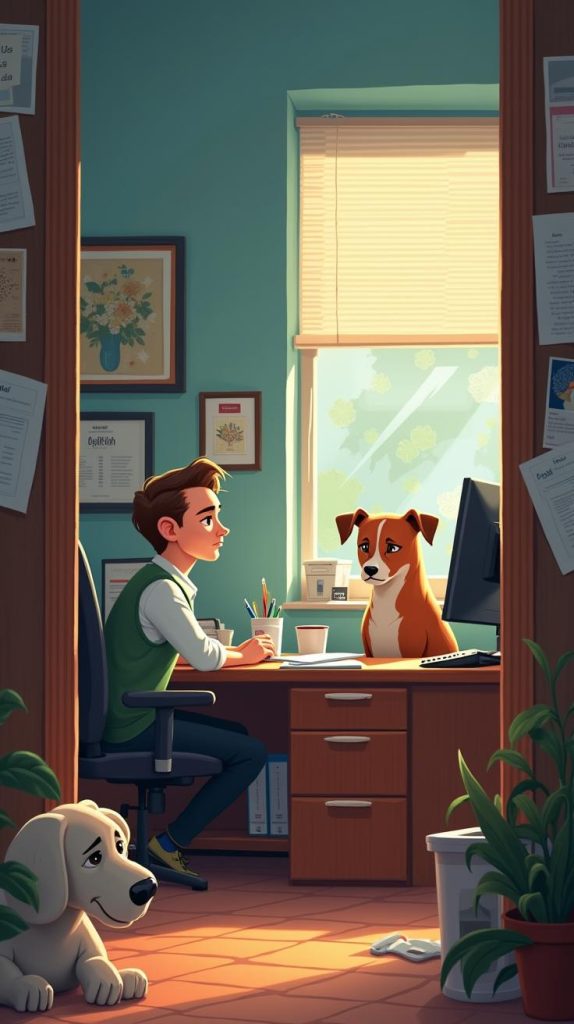WIBTA for asking my boss to remove her dog from my office?
 Image credit: Pixabay (This is example image – Not the actual photo)
Image credit: Pixabay (This is example image – Not the actual photo)
Dog Duty Dilemma: A Front Desk Frustration
In a bustling clinic, a front desk receptionist finds herself juggling multiple roles, including an unexpected one as a dog sitter for her boss’s beloved but poorly trained therapy dog. With the canine’s frequent accidents and unpleasant odors permeating her workspace, she grapples with the challenge of addressing her discomfort without jeopardizing her job. This relatable scenario raises questions about workplace boundaries and the responsibilities we take on for others, especially when it comes to pets. Can she advocate for her own comfort without becoming the villain in her boss’s eyes?
Family Drama at Work: A Dog Dilemma
In a busy clinic environment, a front desk receptionist finds herself entangled in an unexpected family drama involving her boss’s dog. The situation has escalated into a conflict that raises questions about responsibility and workplace boundaries.
- Job Responsibilities: The receptionist manages both administrative tasks and front desk duties, which already demands a significant amount of her time and energy.
- Unexpected Pet Care: In addition to her regular duties, she is also responsible for walking her boss’s small dog multiple times a day. This arrangement was not part of her job description.
- Dog’s Behavior: The dog, claimed to be a service animal, often displays poor behavior. It is not adequately trained and has a tendency to relieve itself in patient treatment rooms if not walked promptly.
- Odor Issues: The dog is older and frequently emits unpleasant odors, which creates an uncomfortable working environment for the receptionist, especially when her office door and window are closed for patient confidentiality.
- Emotional Attachment: The dog holds significant emotional value for the boss, making it challenging for the receptionist to address her concerns without risking an emotional reaction.
- Lack of HR Support: The clinic lacks a traditional HR department, as the HR representative is also the boss’s vice president, complicating the situation further.
- Additional Responsibilities: The boss has even arranged for her spouse to bring the dog in for the receptionist to care for while she is away, further blurring the lines of responsibility.
- Crate Location: The dog’s crate is situated in the receptionist’s office, which is visible to patients, raising concerns about professionalism and hygiene.
Given these circumstances, the receptionist is contemplating whether it would be inappropriate to request that her boss relocate the dog’s crate to her own office. She feels overwhelmed by the additional responsibilities and is concerned about the impact on her work environment.
This situation highlights the complexities of workplace dynamics, particularly when personal attachments and professional boundaries intersect. The receptionist is seeking a resolution that respects her role while addressing the discomfort caused by the dog’s presence.
In navigating this conflict, it is essential to consider effective conflict resolution strategies that maintain professionalism and promote a healthy work environment. The receptionist must weigh the potential fallout of her request against her need for a more comfortable workspace.
This is Original story from Reddit
 Image credit: Pixabay (This is example image – Not the actual photo)
Image credit: Pixabay (This is example image – Not the actual photo)
My Experience at the Clinic
I work in a clinic at the front desk window. I have my own little office space away from the rest of the staff who work in the back office. The company president, my boss, has a small dog that she brings in every day that has become my responsibility.
In addition to working as both the administrator and front desk receptionist, I am also required to walk her dog several times a day. If the dog isn’t walked efficiently and isn’t crated, it’s prone to shitting in patient treatment rooms. The dog is supposedly a service dog that acts as a ‘therapy dog’ for patients, but aside from basic commands like “sit,” it seems hardly trained and is rarely used as such.
What’s difficult for me is that the dog is older and often either smells bad or has gas, usually both. To make matters worse, my door and window often have to be closed as I am frequently calling to discuss patient details, which makes me trapped in the smell. That dog is the world to my boss, so I know that if I bring it up, she will be emotionally reactive, and we don’t have any real HR; our HR rep is her VP.
She has even had her spouse bring in the dog for me to watch while she is out of town, away from the office. I feel like, in addition to working as both a receptionist and an administrator, I’m also stuck as a pet sitter for someone else’s pet. She has her own office, so I don’t understand why the crate has to be in mine, especially since it’s in sight for patients to see.
Would I be the asshole to ask that she move the crate into her office? I know it’s not my company, but that dog reeks something fierce. I don’t get why her pet has to be my responsibility.
View the Original Reddit Post Here
Summary of Reddit Comments
The top Reddit comments indicate a strong consensus that the original poster (OP) is not at fault (NTA) for being expected to care for the company president’s dog, which many users view as an unreasonable and inappropriate demand. Commenters suggest that the OP should consider leaving the job rather than confronting the issue directly, as it could lead to negative repercussions. Overall, the comments highlight a shared belief that the responsibility for the dog should not fall on the OP, emphasizing the need for better workplace boundaries.
Verdict: NTA
Expert Advice for Resolving the Conflict
In navigating the delicate situation between the receptionist and her boss regarding the dog, it’s essential to approach the matter with empathy and professionalism. Here are practical steps to help resolve the conflict while maintaining workplace harmony:
For the Receptionist
- Assess Your Feelings: Take some time to reflect on how the dog’s presence affects your work environment. Write down specific instances that have caused discomfort or distraction to clarify your thoughts.
- Document Responsibilities: Create a list of your job responsibilities and highlight the additional tasks related to the dog. This will help you articulate your concerns clearly when discussing the issue.
- Request a Meeting: Schedule a private meeting with your boss to discuss your workload. Choose a time when your boss is likely to be less stressed and more receptive to conversation.
- Communicate Clearly: During the meeting, express your feelings about the additional responsibilities in a calm and respectful manner. Use “I” statements, such as “I feel overwhelmed with my current workload and the added responsibility of caring for the dog.”
- Propose Solutions: Suggest practical solutions, such as relocating the dog’s crate to a less visible area or hiring a pet care service during work hours. This shows that you are willing to find a compromise.
- Set Boundaries: If the conversation goes well, establish clear boundaries regarding your responsibilities. Make it clear that while you care about the dog, your primary focus must remain on your job duties.
- Consider Your Options: If the situation does not improve after your discussion, consider whether this job aligns with your professional goals and personal well-being. It’s okay to prioritize your mental health.
For the Boss
- Listen Actively: When the receptionist approaches you, listen to her concerns without becoming defensive. Acknowledge her feelings and the impact the dog’s presence may have on her work.
- Evaluate Responsibilities: Reflect on the appropriateness of expecting your receptionist to care for your dog. Consider whether this expectation aligns with her job description and professional boundaries.
- Explore Alternatives: If the dog’s presence is important to you, consider hiring a professional pet sitter or dog walker during work hours to alleviate the burden on your receptionist.
- Relocate the Dog’s Crate: If feasible, move the dog’s crate to a different area of the clinic that is less disruptive to the receptionist’s work environment and patient interactions.
- Foster Open Communication: Encourage an open-door policy where employees feel comfortable discussing their concerns. This can help prevent misunderstandings and foster a positive workplace culture.
- Reflect on Workplace Dynamics: Consider how personal attachments, like your bond with your dog, can impact professional relationships. Strive to maintain a balance that respects both personal and professional boundaries.
By taking these steps, both the receptionist and her boss can work towards a resolution that respects the needs of both parties while fostering a healthier work environment. Open communication and mutual respect are key to navigating this family drama at work.
Join the Discussion
 Image credit: Pixabay (This is example image – Not the actual photo)
Image credit: Pixabay (This is example image – Not the actual photo)
What do you think? Would you have handled this differently?
Share your thoughts below! Vote: Do you agree with Reddit’s verdict?









